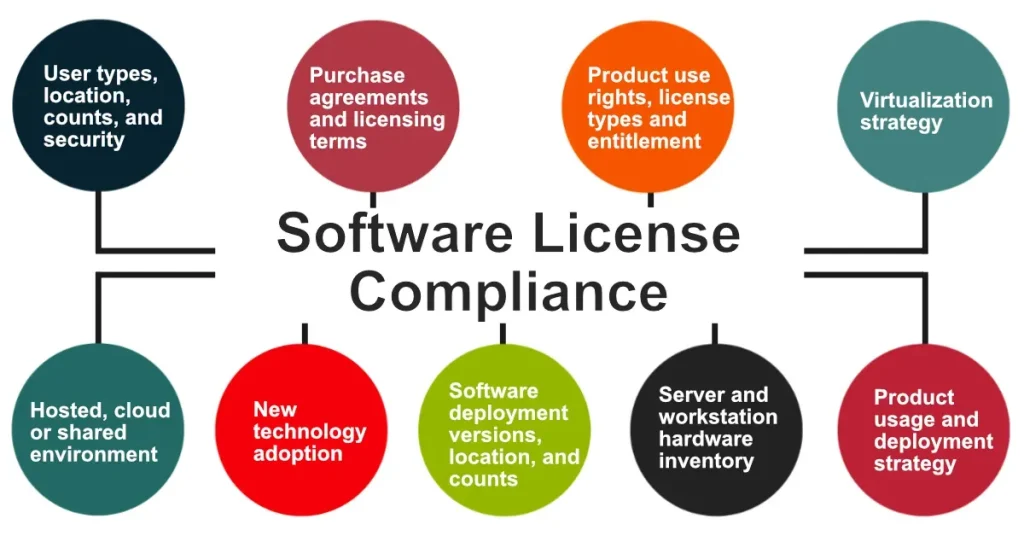Software licensing and compliance sit at the core of responsible software use in modern organizations, guiding how teams purchase, deploy, and govern technology while ensuring alignment with vendor terms and risk controls. For newcomers, understanding software license types helps you distinguish between proprietary, open-source, per-user, and subscription models and sets expectations for what is allowed in your environment; in practice, this foundation supports budgeting, governance, and risk management for both on-premises and cloud deployments. Effective software license management turns policy into practice by automating discovery, entitlement tracking, and renewal planning, so you can optimize spend and minimize audit risk; this continuous cycle helps align IT, procurement, and legal teams around a single, auditable data set. Open-source license compliance adds a distinct layer, requiring SBOMs, attribution, and redistribution obligations, and teams improve outcomes by following license compliance best practices such as automated scanning and governance; this means maintaining clear provenance for dependencies, documenting decision points, and integrating OSS checks into CI/CD pipelines. With a clear software asset management framework, you can prepare for audits and maintain ongoing compliance with well-documented processes, policies, and evidence that support compliance audits for software; this steady approach reduces surprises, accelerates vendor negotiations, and demonstrates governance maturity to stakeholders.
Viewed through a broader lens, this discipline becomes software asset governance, covering licensing agreements, usage rights, and ongoing risk management rather than only a legal obligation. Organizations implement structured procurement controls, device and user provisioning, and renewal strategies to keep deployments aligned with policy and budget. The focus is on visibility into licenses, vendor terms, and the use of tools that monitor deployments, detect gaps, and support decision-making. From a governance standpoint, embracing rigorous OSS handling, license tracking, and renewal planning reduces exposure during compliance reviews and keeps teams coordinated.
Software licensing and compliance: A practical framework for sustainable governance
Software licensing and compliance form the backbone of responsible software use. A license defines who may use the product, how many devices, whether modifications are allowed, and the penalties for non-compliance. When organizations align licensing with governance, they tame risk, optimize spend, and support a repeatable process within software asset management (SAM). By mapping software license types, which helps you choose models that fit usage patterns and budgets, you gain visibility that drives procurement, deployment, and retirement decisions while staying within the terms of each agreement.
To operationalize this, implement a repeatable process: centralize policy and governance, adopt a reliable software license management (SLM) solution, and integrate with procurement and renewal workflows. This enables license reconciliation, usage monitoring, and renewal planning, while preparing for compliance audits for software. Emphasize license compliance best practices: maintain an SBOM for OSS, standardize approval workflows, and train teams on licensing distinctions between licenses and subscriptions to prevent over- or under-licensing.
Open-source license compliance and software license management: Balancing risk and value
Open-source license compliance is a critical dimension of modern software delivery. OSS can accelerate development and reduce costs, but it also imposes obligations from permissive licenses to copyleft terms. Maintaining an up-to-date SBOM, applying software composition analysis (SCA), and enforcing attribution and redistribution rules are essential components of open-source license compliance. In practice, organizations should distinguish between open-source license compliance and broader software license management to avoid blind spots.
Establish a governance program that includes OSS approvals, automated scanning, ongoing training, and regular audits. With robust software license management, you can consolidate entitlements, track usage, and prepare for compliance audits for software. Align procurement with policy, centralize license documentation, and use renewal calendars to stay ahead of risk while unlocking the value of open components.
Frequently Asked Questions
What is software licensing and compliance, and why is it essential for managing software license types and compliance audits for software?
Software licensing and compliance define how software may be used, installed, and redistributed. It matters because non-compliance can lead to financial penalties, legal risk, and wasted spend. To stay protected, improve visibility with a Software Asset Management (SAM) program: maintain an up-to-date inventory of all software and entitlements, map licenses to procurement, deployment, and retirement, and regularly reconcile license types (per-user, per-device, subscription, floating). For open-source software, maintain an SBOM and use license scanning to enforce OSS license compliance. Prepare for audits by keeping evidence such as contracts, receipts, and usage reports.
What is the role of software license management in achieving license compliance best practices and open-source license compliance across an organization?
Software license management is the repeatable process to track, optimize, and renew licenses, enabling license compliance best practices. It connects license data with procurement, deployment, maintenance, and retirement to reduce risk and cost. Key steps include automated discovery of installed software, entitlement reconciliation, usage monitoring, and renewal planning, plus governance for OSS with SBOMs and open-source license compliance controls. Centralize license repositories and policies to stay audit-ready and support compliance audits for software.
| Topic | Key Points |
|---|---|
| What is software licensing and why it matters | Licensing governs use, installation, and redistribution; compliance reduces penalties, waste, and disputes; enables visibility and control via SAM. |
| Path to licensing and compliance | Requires visibility: know what you own, where it’s installed, who uses; creates a single source of truth; ties to procurement, deployment, retirement. |
| Common license types | Proprietary; Per-user; Per-device; Subscription; Floating/concurrent; Open-source. |
| Open-source license compliance: obligations and benefits | OSS licenses vary; permissive vs copyleft; compliance includes attribution, notices, distribution obligations, and redistribution obligations. |
| OSS governance actions | Maintain SBOMs, use license scanning and policy controls, document obligations during procurement and integration. |
| Software license management: repeatable process | Inventory, license reconciliation, usage monitoring, renewal planning, vendor management. |
| Best practices for license compliance and governance | Centralize policy; clear procurement; ongoing training; automation; audit readiness. |
| Common pitfalls and remedies | Shadow IT; unapproved OSS; under- or over-licensing; neglected renewals; inadequate documentation; apply automation and governance to remedy. |
| 7-step beginner’s plan to software licensing and compliance | 1) Map landscape; 2) Classify licenses; 3) Align procurement; 4) Implement tooling; 5) OSS governance; 6) Prepare for audits; 7) Review quarterly. |
| Audits and ongoing compliance: what to expect | Maintain inventory and entitlements; collect receipts and contracts; generate usage reports; document governance. |
| Tools and resources to support licensing and compliance | SAM platforms; SCA tools for OSS; ITAM integration; contract repositories. |
Summary
Software licensing and compliance is a strategic capability that protects organizations, optimizes technology spend, and accelerates software delivery. By understanding license types, embracing open-source compliance, implementing software license management, and following best practices, organizations can establish a resilient governance model. With a clear 7-step plan and the right tooling, even beginners can lead a licensing and compliance program that scales with your organization.



